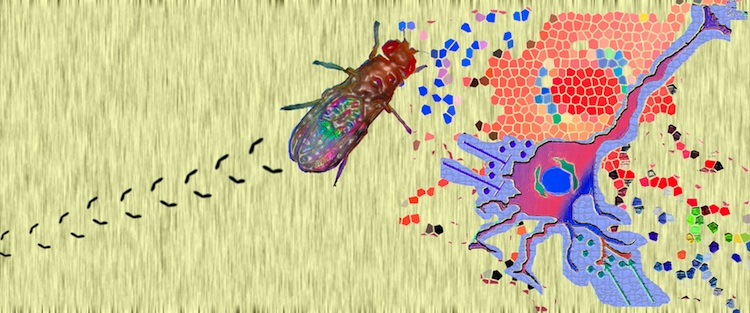O Drosophila, even closer dost thou model Homo sapiens!
Imagine a computer as sophisticated as is currently possible - a vast array of silicon-based interconnecting pathways. Even this would still be a primitive device compared to a mammalian Central Nervous System (CNS). The fundamental units of the CNS, the neurons, interact at junctions called synapses through their branched projections, the dendrites. The accurate and precise development of the branching patterns formed by dendrites is thus essential for the emergence of a functional network of neurons.
A team of developmental biologists at NCBS-TIFR Bangalore (Ajeet Singh, K. VijayRaghavan and Veronica Rodrigues) has recently identified a neuron in the CNS of the fruit fly Drosophila that can be used as a model to study the growth and refinement of dendritic patterns during development. The results were published in the journal Development (see Abstract here). Their wide-ranging study identified many factors that play a part in dendritic regulation, but most interestingly they found that the architecture of the dendrites in the adult nerve was determined by the nerve having the appropriate activity and inputs in the larval stage. The study indicates that neuronal development in Drosophila is more similar to that of vertebrates than was previously thought. There are contributions by the ensemble of Nature and Nurture - genetic factors as well as environmental cues.
Drosophila has long been used as a model organism for studying developmental biology and genetics. It has two different body forms – the larval maggot and the familiar fly. During metamorphosis, the adult body undergoes significant remodeling, but the authors identified a neuron - called CSDn - that is retained during the transition. In vertebrates it is known that dendritic connections that are much used during development are strengthened and retained, whereas those that are under-used are removed - a phenomenon called "refinement". But this activity-dependent stabilization/refinement had never previously been demonstrated as a feature of Drosophila development.
“In contrast to the general belief before the study that neuronal circuit formation in Drosophila is ‘hard wired’ or completely genetically driven - without any contribution from neuronal activity - we identified a central neuron, CSDn, whose dendritic refinement was significantly regulated by neuronal activity”, says Ajeet Singh, the principal author of the study. In what was the single most important experiment, the authors compared the architecture of the dendrites of CSDn in wild type adult Drosophila with that in a line where the activity of CSDn had been silenced during metamorphosis. (CSDn was silenced by the targeted expression of a human potassium ion channel that hyperpolarized the membrane potential.) It was observed that the CSDn in the silenced genotype had ‘excess’ dendritic arbors - they had not been refined.
Two other lines of evidence also directly supported the importance of neuronal activity for proper refinement. Examining a mutant (called aristalesss) that lacks some nerves that possibly provide input for CSDn, the authors found that refinement of CSDn’s dendrites was reduced. The authors also found reduced refinement in flies with a conditional allele of gene paralytic (para) that causes animals to undergo paralysis, and reduces general nerve activity at temperatures above 29⁰C.
Finally, there was subtle support from two further experiments. The activity-dependent sculpting of dendritic branching in vertbrates depends on the normal activation and operation of a specific class of neuronal receptors, the NMDARs (N-methyl-D-asparate glutamate receptors). When NMDAR function was knocked out in CSDn - by targeted RNAi of the receptor itself - proper refinement did not occur. And refinement was also compromised when a signaling pathway generally important in development (Wnt signaling) was downregulated.
Putting all their observations together, the authors propose that during normal metamorphosis, aristal neurons trigger neuronal activity in the CSDn, thus stabilizing the developmentally optimal connectivity between these neurons. NMDA receptors are crucial for the selective stabilization/refinement of dendritic arbors, and the final dendritic pattern is also influenced by Wnt signaling.
The authors are yet to identify all the mechanisms by which ‘appropriately connected’ synapses are strengthened, whereas others are eliminated. “We are not yet too sure of various hallmarks of synapse stability”, remarks Ajeet. Also, questions remain as to whether the same mechanisms indicated for CSDn also operate in the development of neurons that use a different neurotransmitter (CSDn relies on serotonin). Nevertheless, the study provides a model neuron for the analysis of the various genetic and environmental factors that regulate dendritic growth and refinement, and emphasises the usefulness of Drosophila as an ideal organism for studying developmental neurobiology.
O Drosophila, even closer dost thou model Homo sapiens!


Comments
my regards to
The way the article started
How far refinement is
Refinement is a crucial
Dear Bunindro. I have alerted
Congrats Ajeet! Nice post.
Amazing read! it's always
Please simplify the article a
Post new comment